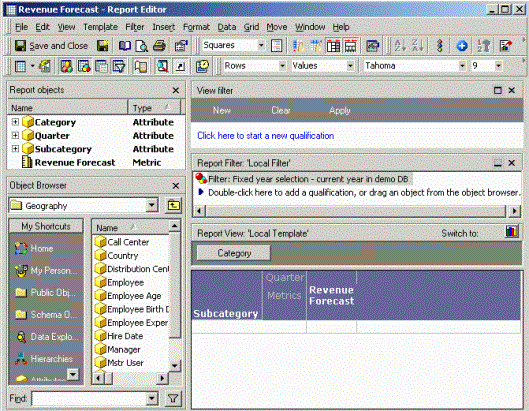MicroStrategy ONE
MicroStrategy Developer Report Editor interface
If you have report designer privileges, you can use the Report Editor in either MicroStrategy Developer or MicroStrategy Web to create new reports in MicroStrategy. (You can of course also access these editors if you have other sets of privileges, such as Administrator, and so on.) Use this section to familiarize yourself with the Report Editor interface. The following image shows the Report Editor in Developer, with the sample Revenue Forecast report ready to be edited within it:

For details on report designer privileges and the report designer role, see Before you begin in Building Query Objects and Queries, for Designers.
Finding your way around the Developer Report Editor
Refer to the image above as you read about the various areas or panes in the Developer Report Editor. You can perform the following tasks within the appropriate Report Editor pane:
-
Report Objects pane: (top left) (This pane appears only if you have MicroStrategy OLAP Services. See OLAP Services for details.) Where you can see a summary of all the objects you have included on your report.
There may be more objects in this pane than are displayed on the executed report, because OLAP Services lets analysts quickly remove or add objects from this pane directly to the report template. When the report is executed, the MicroStrategy Engine generates SQL that includes all the objects in this Report Objects pane, not just the objects that are displayed in the report after it is executed. For details on using the Report Objects pane, see Designing reports that use OLAP Services.
- Object Browser pane: (center left) Where you navigate through the project to locate objects to include on the report. For details on report objects, see MicroStrategy objects.
- My Shortcuts pane: (bottom left) Enables you to access any folder in the Object Browser quickly. Creating shortcuts can save you time if you repeatedly browse to the same folders. For details on creating shortcuts, see Quick object access: Creating shortcuts to objects.
- View Filter pane: (top right) (This pane is only available if you have MicroStrategy OLAP Services. See OLAP Services for details.) Where you apply a special kind of filter to any object that is in the Report Objects pane. View filters do not modify the SQL for the report like normal report filters do. Instead, view filters are applied to the overall result set after the SQL is executed and results are returned from the data source. This can help improve report execution performance. For details on using view filters, see Designing reports that use OLAP Services.
- Report Filter pane: (center right) Where you add filtering conditions to a report. Filtering conditions can be made up of attributes, metrics, advanced filter qualifications, and shortcuts to an existing report filter. The Report Filter pane allows you to create a filter without having to open a separate object editor (the Filter Editor). Simple filters can be conveniently created by dragging and dropping objects from the Object Browser into this pane to create a filter. For details on creating filters, see Filtering data on a report: Filters.
- Report View pane: (bottom right) Where you define your report layouts by dragging and dropping objects from the Object Browser onto this report view pane. You can create a report to serve as a template for other reports; for details on templates, see Designing a report's structure: Templates.
- Page-by pane: (top of Report View pane) Where you place subsets of your report results to be displayed as separate pages of the executed report. For details on adding page-by functionality to a report, see Grouping data by page.
